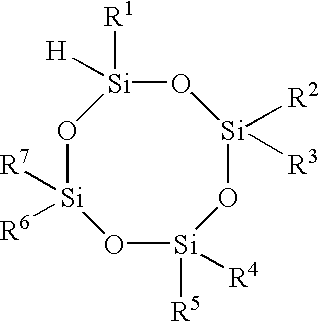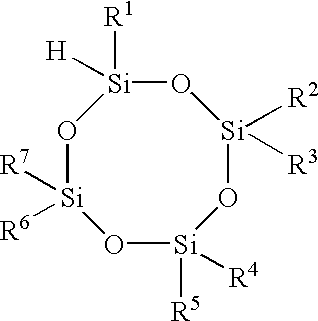Stabilizers to inhibit the polymerization of substituted cyclotetrasiloxane
a technology of stabilizer and cyclotetrasiloxane, which is applied in the direction of chemical apparatus and processes, organic chemistry, coatings, etc., can solve the problems of tomcats type siloxane's instability in polymerization, limited acceptance of tomcats type siloxane as a cvd source for semiconductor device manufacturing, and low volatility liquid or gel
- Summary
- Abstract
- Description
- Claims
- Application Information
AI Technical Summary
Benefits of technology
Problems solved by technology
Method used
Image
Examples
example 1
Blank
In general a one or two blanks (additive-free TOMCATS type siloxane) were run for every set of stability experiments described in this invention. Several different batches of TOMCATS type siloxane source material were used. For the sake of clarity, all the results from the blank experiments were included in this example. The volume of the ampoules used for these tests was typically 80-90 ml. The quartz ampoules were routinely cleaned by rinsing with distilled water, then with reagent grade acetone. The rinsed ampoules were placed into a drying oven at 175° C. for a minimum of 4 hours. The dry ampoules were removed from the oven and used while still warm. 3.0-7.0 ml of TOMCATS type siloxane were loaded into each ampoule. Teflon valves were attached to the open end of the ampoules, and the TOMCATS type siloxane was cooled by immersing the end of the ampoules into a liquid nitrogen bath. The air was removed from the ampoules by subjecting them to vacuum for 5 minutes. The ampoules...
example 2
Spike of 100 ppm of 2,4-pentanedione
In a typical experiment 0.50 microliters of 2,4-pentanedione was added to an ampoule previously cleaned and dried as described in Example 1. To this ampoule 5.0 ml of TOMCATS type siloxane was added, taking care to rinse down any residual 2,4-pentanedione liquid that remained adhered to the inner wall of the ampoule. The ampoule thus prepared contained TOMCATS type siloxane with 100 ppm by volume of 2,4-pentanedione. The ampoule was sealed and heated for 5 days at 120° C. as described in Example 1. There was no detectable change in the viscosity, color or clarity of the TOMCATS type siloxane sample by visual inspection after the completion of the accelerated aging test as compared to the pristine sample prior to testing. Similar tests were done on 3.0 ml to 7.0 ml samples of TOMCATS type siloxane spiked with 100 ppm of 2,4-pentanedione additive. In each case there was no detectable visible changes in the sample after testing. These samples showed ...
example 3
Spike of 1000 ppm of 2,4-pentanedione
In a typical experiment 5.0 microliters of 2,4-pentanedione was added to an ampoule previously cleaned and dried as described in Example 1. To this ampoule 5.0 ml of TOMCATS type siloxane was added, taking care to rinse down residual 2,4-pentanedione liquid that remained adhered to the inner wall of the ampoule. The ampoule thus prepared contained TOMCATS type siloxane with 1000 ppm by volume of 2,4-pentanedione. The ampoule was sealed and heated for 5 days at 120° C. as described in Example 1. There was no detectable change in the viscosity, color or clarity of the TOMCATS type siloxane sample by visual inspection after the completion of the accelerated aging test as compared to the pristine sample prior to testing. Similar tests were done on 3.0 ml to 7.0 ml samples of TOMCATS type siloxane spiked with 100 ppm of 2,4-pentanedione additive. In each case there was no detectable visible changes in the sample after testing. These samples showed an ...
PUM
| Property | Measurement | Unit |
|---|---|---|
| boiling points | aaaaa | aaaaa |
| boiling points | aaaaa | aaaaa |
| temperature | aaaaa | aaaaa |
Abstract
Description
Claims
Application Information
 Login to View More
Login to View More - R&D
- Intellectual Property
- Life Sciences
- Materials
- Tech Scout
- Unparalleled Data Quality
- Higher Quality Content
- 60% Fewer Hallucinations
Browse by: Latest US Patents, China's latest patents, Technical Efficacy Thesaurus, Application Domain, Technology Topic, Popular Technical Reports.
© 2025 PatSnap. All rights reserved.Legal|Privacy policy|Modern Slavery Act Transparency Statement|Sitemap|About US| Contact US: help@patsnap.com



